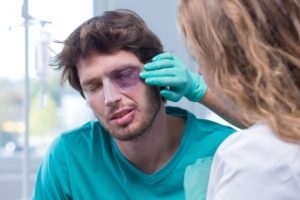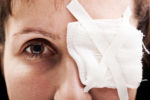 Eye injuries are surprisingly common, and there are many different types of eye injury.
Eye injuries are surprisingly common, and there are many different types of eye injury.
Chemical Contaminants
If you get a chemical into the eye, it needs to be washed out as soon as possible. Ideally, you should use either an eyewash station (common in factories and laboratories) or proper eyewash, normally a type of saline solution. However clean, running water will suffice. If you tilt the person’s head to one side and run the eye under the liquid. If you are using water, make sure that the water is a suitable temperature (not too hot or cold). Tilting the head to one side allows the chemical to run out of the eye, aided by the eyewash. Just make sure you are not washing the chemical into the other eye.
If possible, try and identify what the chemical is, its concentration and even if possible, the volume in the eye. This sort of information is invaluable to the emergency services as they will be able to identify any immediate issues relating to that chemical.
Cuts
With cuts, there are two main types of cut which can happen involving the eye. The first is a cut to the skin surrounding the eye, and the second is a cut or an embedded object on the eyeball itself. When the skin around the eye is cut, whether that be the eyelid or general surrounding skin, the First Aid required is not that complicated. In your First Aid kit, hopefully, you will have an eye patch dressing. Depending on the size and situation of the cut, this will suffice until the emergency services arrive.
Applying direct pressure over the wound will also help, as long as you are not pressing into the eyeball itself. Especially if the cut is above the eye, their eyesight may become restricted due to blood covering the eye. This may well start to distress the patient, so keep talking to them and keep them calm. Constantly reassure them, but also be very careful that they themselves are not doing more damage by moving their eyes.
One thing to make sure of is that the eyes track together. If you were just to cover one eye up and leave the other exposed, then both eyes will move when the person looks around. This would not present much of a problem if it were a cut on, for example, the eyelid. However, if the situation includes something such as an embedded object, moving the eyeball can cause serious problems. Therefore you would need to make sure that both eyes are covered.
To do this, first of all, get the patient to sit down. Then get them to cup their hands over their eyes and then get them to lean forward. If there is a large embedded object, make sure that that does not move either. Keep your hand on their shoulder just so that they know you’re there, and keep talking to them. Make sure that the emergency services are on their way, and they will be able to offer you more advice whilst you are on the phone to them.
Foreign Objects
Foreign Objects in the eye can be very distressing for the patient, but more importantly, if not dealt with properly, could cause serious damage to the patient. Click here to go to a separate page which is dedicated to the removal of foreign objects.
Eye Dressings
If you are moving somebody who has any sort of eye injury, be very careful as their vision may be compromised. Support them, guide them and help them to get to where they need to be. There are standard eye dressings in most first aid kits. Once opened, place it over the eyes, making sure no hair will get caught. Then just bring the bandage round to the back and tie it off. With any dressing on the head, just be careful you are not covering the ears up. It is bad enough that they may have, albeit temporarily, lost sight, the last thing you want to do is also restrict hearing. Just bandage that up and check it’s all okay. But it might be a good idea to give them another dressing, or some tissues, so they can mop up any blood which may be running down their face.
For more information on training courses, visit our “Courses” page which also includes our First Responder and First Person on Scene (FPOS) Courses.


Thanks for the excellent manual